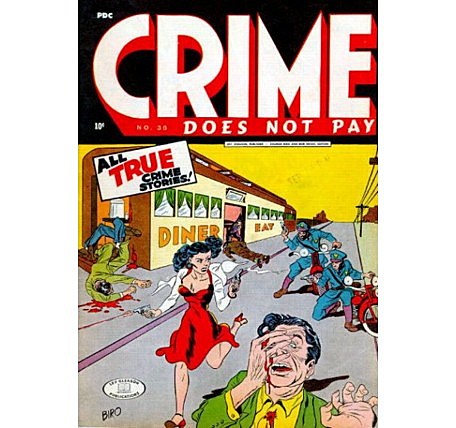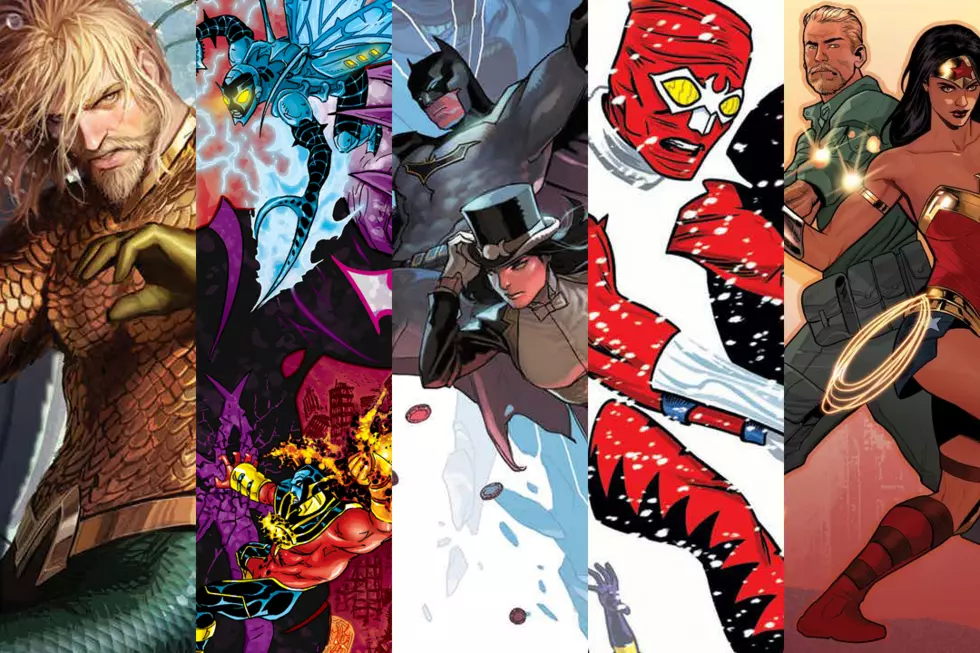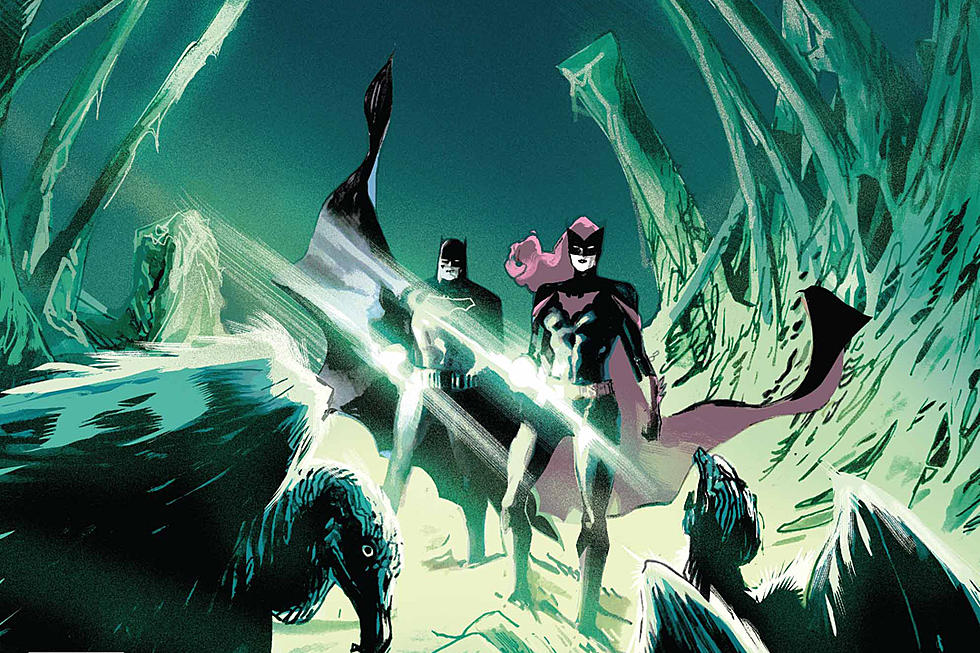
Crime Pays: The Greatest Crime and Noir Comics, Old and New
 Crime is in. Although noir and crime stories were wildly popular in comics during the 40s and 50s, thanks to the ultra-conservative Comics Code of 1954, it soon became almost impossible to tell gritty, sexy stories about bad men and beautiful dames. But over 50 years later, we've suddenly found ourselves in the middle of a noir renaissance, with scripting star Ed Brubaker winning Eisner Award after Eisner Award for his spectacular crime serial, "Criminal," and Darwyn Cooke's adaptation of Richard Stark's "Parker: The Hunter" almost sure to make Top 10 lists for 2009.
Crime is in. Although noir and crime stories were wildly popular in comics during the 40s and 50s, thanks to the ultra-conservative Comics Code of 1954, it soon became almost impossible to tell gritty, sexy stories about bad men and beautiful dames. But over 50 years later, we've suddenly found ourselves in the middle of a noir renaissance, with scripting star Ed Brubaker winning Eisner Award after Eisner Award for his spectacular crime serial, "Criminal," and Darwyn Cooke's adaptation of Richard Stark's "Parker: The Hunter" almost sure to make Top 10 lists for 2009.
Even Marvel Comics has joined the party with its "Noir" line of superhero titles, which reimagines superheroes like the X-Men or Spider-Man in dark and pulpy settings. Of course, the imprint is inevitably becoming a little absurd with books like this week's "Punisher Noir" #1 -- because the original Punisher story about a war veteran who had put aside his killing ways until his family was murdered by the mob and is now out for revenge after was apparently not noir enough on its own.
Regardless, there's shortage of great hard-boiled crime comics out there, and Chris Sims of the Invincible Super-Blog has put together a list of the best, both old and new.
Justice Traps the Guilty

Crime was one of the most popular genres in the early days of comics, and since Jack Kirby and Joe Simon invented the romance comic together (and then one of them went on to invent pretty much everything else), it shouldn't come as a surprise that they were also active in the early days with "Justice Traps the Guilty." They were far from the only luminaries working on crime books, too: Plastic Man creator Jack Cole's famous scene of a woman getting stabbed in the eye with an icepick raised some concerns, as it was a scene of a woman getting stabbed in the eye with an icepick:
It Rhymes With Lust

Considered the first graphic novel by most people who aren't Will Eisner, "It Rhymes With Lust" was produced and marketed as as a black-and-white paperback "Original Picture Novel" that told the adult-oriented story of the beautiful Rust Masson and the crooked political machine she controlled. Co-written by future "Doom Patrol" creator Arnold Drake with art by Matt Baker -- whose famous bondaged-up Phantom Lady cover made an appearance in "Seduction of the Innocent" -- "It Rhymes With Lust" was re-released by Dark Horse in 2007 after decades out of print.
Crime Does Not Pay

While EC gets the lion's share of attention when it comes to the senate hearings that led to the Comics Code in the '50s, Lev Gleason's "Crime Does Not Pay" rode a wave of parental outrage to a purported circulation of over five million copies thanks to Bob Wood and Charles Biro's lurid, blood-soaked depictions of "true" tales of mobsters. Unfortunately for crime fans, a toned-down "Crime Does Not Pay" lasted less than a year after the Comics Code Authority left it to bleed out, gutted like a stoolie on the docks.
Lois Lane

Dr. Scott wrote the definitive review of this one as part of his series on PSA comics, but in one of the strangest marriages of super-hero comics and noir storytelling, Mindy Newell and Gray Morrow's two-issue "Lois Lane" series from 1986 saw Superman's Girl Friend dealing with the tragedy of missing and exploited children, with a suitably depressing ending in which absolutely nothing changes. And even stranger (and darker) is the revelation that Superman's Other Girl Friend Lana Lang was once married in Europe and had a son that was kidnapped and murdered by terrorists who cut off his ear and sent it to her before killing him. According to the story, she keeps the ear in a safe deposit box.
For obvious reasons, this was never mentioned again.
Road to Perdition

Made into a very successful Tom Hanks picture in 2003, "Road to Perdition" was loosely based on "Lone Wolf and Cub" -- in which the shogun's top executioner is betrayed and is forced to flee while battling his enemies -- but with feudal Japan swapped out in favor Depression-era mobsters. It also has the distinction of a strange quirk of the publishing world: Creator Max Alan Collins, a notable crime novelist in his own right with several movie tie-ins under his belt, ended up writing the novelization of the "Road to Perdition" movie, adapting something that was itself an adaptation of something he already wrote.
Sin City

Any discussion of crime and noir comics would be woefully incomplete without "Sin City," the book where Frank Miller mainlined Mickey Spillaine onto the comics page for a world of tougher-than-tough guys and women for whom "broad" and "dame" are among the more polite ways to describe them.
100 Bullets

Brian Azzarello and Eduardo Risso's long-running Vertigo series "100 Bullets" started with a simple premise -- a mysterious man showing up and offering people who had been wronged a gun and a hundred untraceable bullets with which to get their revenge -- but spun out over 100 issues into a sprawling crime and conspiracy story that connects everything from the colonization of North America to the bright lights of Atlantic City.
Powers

Brian Bendis already had experience in both true crime stories ("Torso") and crime fiction ("Jinx") when he teamed up with artist Michael Avon Oeming to tie crime to super-heroes in a series focused on two detectives working the super-human homicide beat.
Gotham Central

If "Lois Lane" was the worst marriage of the crime and super-hero genres, then Greg Rucka, Ed Brubaker and Michael Lark's "Gotham Central" was far and away the best. The series dealt with Gotham City's Major Crimes Unit, the police assigned to deal with super-human threats, showing the alternating resentment and appreciation of the world's greatest vigilante, what happens when normal cops are faced with criminals who pack freeze-rays and mind-control hats, and, in one amazingly harrowing story, what happens when the police actually arrest the Joker.
Criminal

Superstar writer Ed Brubaker caught a lot of readers' eyes with his noir-tinged "Scene of the Crime," which led to an underappreciated run on "Batman" and the aforementioned "Gotham Central." With "Criminal," though, he returned to his roots with artist Sean Philips, who had previously worked with Brubaker on the super-hero espionage thriller "Sleeper," for a book that not only featured some of the greatest crime stories in comics, but also ran essays on film noir from Warren Ellis, Patton Oswalt, Matt Fraction, Hard Case Crime writer Charles Ardai, Steven Grant, and others.
Richard Stark's Parker: The Hunter

With a design sense that fits the era perfectly, Darwyn Cooke's new adaptation of the novel by Richard Stark (a pen name for writer Donald Westlake) is about a hard man who was betrayed by the woman he loved and left for dead coming back to get his revenge with nothing but his bare hands, a chip on his shoulder, and a growing list of people to kill. In other words, this sucker is about as noir as it gets.
More From ComicsAlliance



![Azrael Returns In ‘Detective Comics’ #950 [Preview]](http://townsquare.media/site/622/files/2017/01/Tec01.jpg?w=980&q=75)





